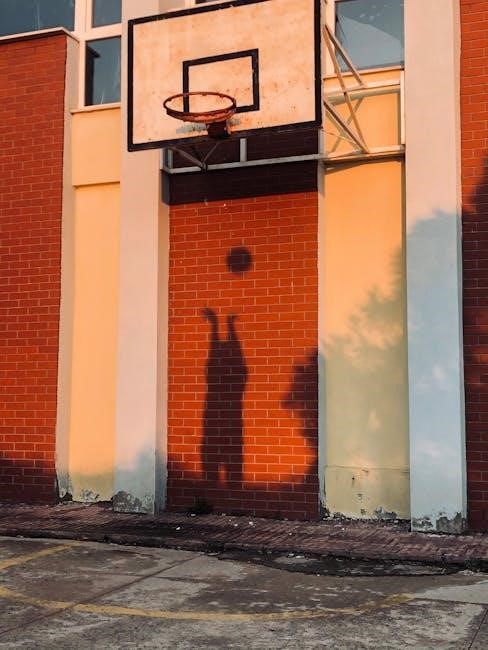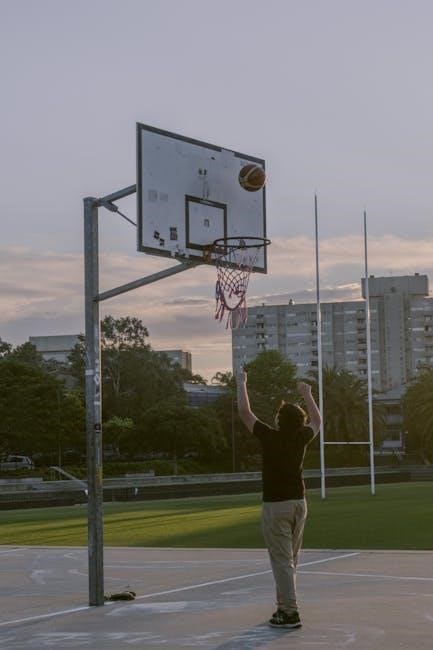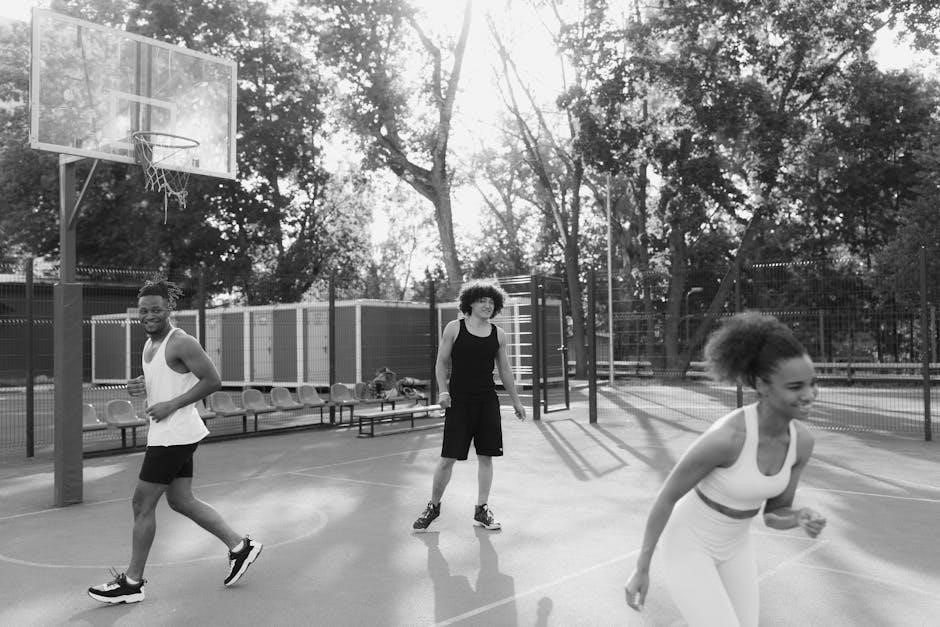The Hook and Ring Game is a timeless classic, easy to learn yet challenging to master․ Players swing a ring on a string, aiming to hook it․ Perfect for all ages and events, it offers endless fun!
History and Origin of the Game
The Hook and Ring Game has a rich history, though its exact origin remains unclear․ It is believed to have evolved from traditional tossing games popular in various cultures․ Known by names like Bimini Ring Toss or Ring on a String, it gained popularity as a simple yet engaging activity for all ages․ The game’s origins likely trace back to carnival games or folk entertainment, where skill-based challenges were common․ Over time, it became a staple at parties, bars, and social gatherings, particularly in coastal regions․ Its simplicity and portability made it a favorite for indoor and outdoor events alike․ Today, the game is enjoyed worldwide, with variations in design and rules but retaining the core concept of tossing a ring onto a hook․ Its enduring appeal lies in its accessibility and the fun it brings to players of all skill levels․ Whether at a casual gathering or a competitive setting, the Hook and Ring Game continues to entertain and challenge enthusiasts everywhere․
Basic Components: Hook, Ring, and String
The Hook and Ring Game consists of three primary components: the hook, the ring, and the string․ The hook is typically a metal or wooden fixture attached to a stable surface, such as a wall or a board․ It serves as the target for the ring․ The ring, usually made of metal, plastic, or wood, is designed to fit snugly over the hook․ The string, attached to the ring, allows players to swing it with precision․ Together, these elements create a simple yet engaging challenge․ The string’s length is adjustable, enabling customization for different skill levels․ Durability is key, as the components withstand frequent use․ Whether for casual fun or competitive play, these basic parts ensure the game remains accessible and enjoyable for everyone․ The design’s simplicity is part of its timeless appeal, making it a favorite at parties, bars, and social gatherings․ By focusing on these core elements, players can master the art of landing the ring on the hook with skill and accuracy․
Setup and Installation Requirements
Setting up the Hook and Ring Game is straightforward and requires minimal effort․ Start by attaching the hook to a sturdy surface, such as a wall, board, or even a tree branch outdoors․ Ensure the hook is securely fastened to withstand repeated use․ Next, tie the string to a fixed point above the hook, like a ceiling beam or a sturdy overhead structure․ Adjust the string length so the ring can swing freely without touching the ground․ For optimal play, the string should be long enough to allow a smooth swinging motion but short enough to maintain challenge․ Use a durable material for the string to prevent breakage․ Once installed, test the setup by swinging the ring to ensure it moves smoothly and aligns well with the hook․ The game is lightweight and portable, making it easy to move between locations․ With proper installation, the game is ready for hours of fun and competition; This simple setup ensures the game is accessible for players of all ages and skill levels․
Indoor vs․ Outdoor Setup
The Hook and Ring Game can be enjoyed in both indoor and outdoor settings, offering flexibility for various occasions․ For indoor setup, attach the hook to a sturdy wall or a wooden board․ Ensure the ceiling or overhead structure is strong enough to hold the string without sagging․ Indoors, the game is perfect for parties, gatherings, or even as a tabletop version, providing entertainment in a controlled environment․ For outdoor use, the setup is similar but often on a larger scale․ Attach the hook to a tree branch, gazebo, or outdoor beam․ Outdoor setups allow for longer strings and more vigorous swings, making it ideal for backyard events or tailgates․ Regardless of the location, ensure the surface is level and the area is clear of obstacles․ The game’s portability and adaptability make it suitable for any setting, whether you’re playing indoors or outdoors․ This versatility ensures endless fun and accessibility for players of all ages and preferences․ Proper installation in either setting guarantees a smooth and enjoyable gaming experience․
Adjusting the String Length

Adjusting the string length is crucial for ensuring the Hook and Ring Game is both challenging and enjoyable․ The string should be long enough to allow a smooth swing but short enough to maintain control․ A common range is 24 to 36 inches, depending on the player’s height and skill level․ For beginners, a shorter string is recommended to make it easier to land the ring on the hook․ As players gain experience, the string can be lengthened to increase difficulty․ To adjust, simply tie or loop the string to the ceiling or hook at the desired length․ Ensure the string is securely fastened to avoid it coming loose during play․ Proper adjustment ensures the game is accessible to all while keeping it exciting․ Always test the swing before starting to confirm the length works well for everyone involved․ This step is vital for a fair and fun experience for players of all ages and skill levels․ Adjusting the string length correctly enhances the overall gameplay and satisfaction․
Safety Tips and Precautions

Ensuring safety is a top priority when playing the Hook and Ring Game․ Always inspect the equipment before use, checking for worn strings or damaged hooks․ Secure the hook firmly to the ceiling or base to prevent it from falling․ Players should stand at a safe distance from the hook to avoid accidental collisions․ Avoid swinging the ring too aggressively, as it may hit nearby objects or people․ Ensure the playing area is clear of breakable items and tripping hazards․ Supervise children closely, as the string and ring can pose choking or entanglement risks․ Wear protective eyewear if necessary, especially for competitive play․ Never leave the game unattended when set up, as it may attract unsupervised use․ Regularly maintain the equipment to ensure durability and safety․ By following these precautions, you can enjoy the game while minimizing risks․ Always encourage responsible and respectful play to create a safe and enjoyable environment for everyone․ Proper care and attention will help prevent accidents and ensure lasting fun․

How to Play the Hook and Ring Game
Players take turns swinging the ring attached to a string, aiming to hook it over the target․ The goal is to score points by successfully landing the ring․ Simple yet engaging, it’s perfect for all skill levels and occasions․ Great fun guaranteed for everyone!

Step-by-Step Gameplay Instructions

To play the Hook and Ring Game, start by ensuring the setup is secure․ Players take turns holding the string with the ring and swinging it toward the hook․ The goal is to loop the ring completely over the hook for a valid score․ Each successful attempt earns one point․ The game continues until a predetermined score is reached, such as 5 or 10 points, and the first player to achieve it wins․ The game is simple yet challenging, requiring precision and control․ It’s ideal for all ages and can be enjoyed in both casual and competitive settings․ Whether at a party, event, or home, the Hook and Ring Game promises fun and excitement for everyone involved!
Scoring System and Winning Criteria
The Hook and Ring Game uses a simple scoring system where each successful ring toss earns the player one point․ The goal is to accumulate points by consistently landing the ring on the hook․ The game typically ends when a player reaches a predetermined score, such as 5, 10, or 15 points, depending on the group’s preference․ The player with the highest score at the end is declared the winner․ For larger groups, the game can be played in rounds, with winners advancing to the next stage․ To ensure fairness, each player should take an equal number of turns․ The game’s straightforward scoring system makes it accessible to all ages while maintaining excitement and competition․ Variations may include bonus points for consecutive successful throws or penalties for missed attempts, adding an extra layer of challenge and fun to the gameplay experience․
Strategies and Tips for Success

Mastering the Hook and Ring Game requires a blend of technique, focus, and practice․ Start by perfecting your swing—gently flick the ring toward the hook using a consistent motion․ Adjust the string length to suit your comfort, ensuring it’s neither too long nor too short․ Aim for the center of the hook to maximize your chances of success․ Pay attention to your stance and grip; a steady hand and balanced posture can significantly improve accuracy․ Experiment with different throwing styles, such as underhand or sidearm tosses, to find what works best for you․ Maintain concentration and avoid distractions during your turn․ Analyze your misses to identify patterns and adjust your aim accordingly․ Stay calm under pressure, especially in close matches, as nerves can affect performance․ For advanced players, try varying the speed or adding subtle spins to the ring for better control․ With patience and persistence, you’ll enhance your skills and become a formidable opponent in this timeless game․
Common Mistakes to Avoid
When playing the Hook and Ring Game, there are several common mistakes that can hinder your success․ One of the most frequent errors is improper setup, such as uneven or unstable installation of the hook, which can affect the ring’s trajectory․ Players often swing the ring with too much force, causing it to overshoot or veer off course․ Another mistake is failing to adjust the string length appropriately, leading to inconsistent tosses․ Some players also neglect to focus on their aim, resulting in missed attempts․ Additionally, improper grip and stance can throw off your balance and accuracy․ It’s important to avoid distractions during your turn and not rush the swing, as this can lead to poor timing․ Lastly, ignoring the string’s condition, such as frays or tangles, can disrupt gameplay․ By being mindful of these pitfalls, you can refine your technique and improve your chances of winning․
Advanced Techniques for Experienced Players
Experienced players can elevate their gameplay by mastering advanced techniques․ One key strategy is spin control, where players impart a subtle spin on the ring to stabilize its flight, increasing accuracy․ Another technique is angled swings, allowing the ring to approach the hook from various directions, making it harder for opponents to predict․ Seasoned players also benefit from precision timing, releasing the ring at the peak of the swing for optimal range and control․ Additionally, reading the string’s movement is crucial; understanding how the string reacts to different swings helps in adjusting shots dynamically․ Advanced players often practice _hook alignment, ensuring the ring is perfectly positioned to catch the hook․ Lastly, environmental adaptation is vital—adjusting swings to account for wind or uneven surfaces․ These techniques require practice but can significantly enhance a player’s performance, setting them apart from beginners․ Mastery of these skills transforms the game into a true test of skill and strategy․
